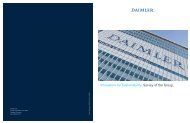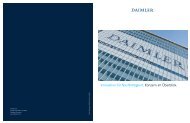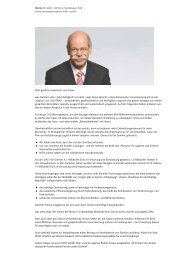Dear readers, This report describes what Daimler means by ...
Dear readers, This report describes what Daimler means by ...
Dear readers, This report describes what Daimler means by ...
Create successful ePaper yourself
Turn your PDF publications into a flip-book with our unique Google optimized e-Paper software.
<strong>Daimler</strong> 360 GRAD - FAKTEN zur Nachhaltigkeit 2008<br />
<strong>Daimler</strong> Nachhaltigkeitsbericht 2008 / Environmental protection, innovation, and safety / Innovation, development and safety /<br />
Climate protection and CO 2 *<br />
Climate protection and CO 2 *<br />
In 2007, the Intergovernmental Panel on Climate Change (IPCC) presented its Fourth Assessment Report. The<br />
<strong>report</strong>’s key findings are:<br />
� The concentration of CO 2 measured in the atmosphere today is significantly higher than it was at the dawn of<br />
the Industrial Revolution (1750). What's more, such a high concentration has not been present for thousands<br />
of years.<br />
Climate change<br />
� The climate changes can be measured on the basis of increasing air and water temperatures, the melting of<br />
snow and ice, and a rising sea level.<br />
� It is considered highly probable that climate change is primarily the result of anthropogenic greenhouse gas<br />
emissions.<br />
� By contrast, the contribution made to global warming <strong>by</strong> natural processes such as volcanism and<br />
fluctuations in solar activity is much smaller and therefore cannot explain the type, pace, and scope of the<br />
climate changes occurring.<br />
� It is also considered highly probable that if CO 2 emissions either remain at current levels or rise, the impact<br />
such emissions will have on the global climate in the 21st century will be more severe than the influences<br />
observed in the 20th century.<br />
It is now widely accepted that the Earth’s climate is changing overall and that human actions are largely<br />
responsible for this development. Transportation is responsible for around 24 percent of the CO 2 emissions<br />
generated <strong>by</strong> human beings in Europe. Passenger car traffic is responsible for 12 percent of the total.<br />
In February 2007, the EU Commission presented a strategy paper that calls on all manufacturers in Europe to<br />
introduce modifications in their new car models to reduce their fleet CO 2 emissions to an average of 130 grams<br />
per kilometer <strong>by</strong> 2012. A further reduction of 10 grams is to be achieved <strong>by</strong> additional measures such as<br />
improving the efficiency of vehicle components (tires, for example) and a gradual transition to fuels containing<br />
less CO 2 . In December 2007, the EU Commission published an initial draft proposal for reducing CO 2 emissions<br />
from passenger cars and light trucks. The legislation process is expected to be completed <strong>by</strong> 2009, after which<br />
the regulation will apply in every EU member state.<br />
Especially in view of the facts outlined above, our strategy continues to aim at further reducing CO 2 emissions<br />
and fossil fuel consumption. Whatever form the EU's still unclear draft proposal for reducing CO 2 emissions of<br />
new vehicles may take, <strong>Daimler</strong> will further reduce the emissions of its European fleet, with the aim of also<br />
meeting the EU fleet consumption target.














